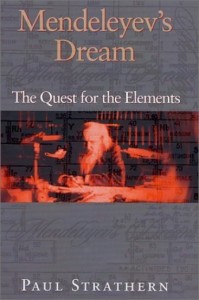By Paul Strathern
 Chemistry has been a neglected area of science writing and Mendeleyev, the king of chemistry, is a largely forgotten genius. Strathern’s insightful history goes a long way towards correcting this injustice.
Chemistry has been a neglected area of science writing and Mendeleyev, the king of chemistry, is a largely forgotten genius. Strathern’s insightful history goes a long way towards correcting this injustice.
Paul Strathern’s first contribution to the popularisation of science was as the author of a series of witty, fast-paced and lucid science booklets published under the broad title of “The Big Idea”, with subtitles such as “Archimedes and the Fulcrum” and “Hawking and Black Holes”. His vivid, pacey style is equally present in his first full-length science book, “Mendeleyev’s Dream”, the story of how the Russian scientist Dmitri Mendeleyev built upon 2,400 years of chemistry to construct the Periodic Table. Just as Newton’s laws and Darwin’s theory of evolution laid the foundation for modern physics and biology respectively, it was Mendeleyev’s Periodic Table that provided the bedrock for chemistry.
There is always a risk that ‘history of science’ books concentrate on the ripping historical yarns at the expense of explaining the science. Strathern avoids this trap, deftly describing the process by which scientific ideas emerge. For example, Mendeleyev’s Periodic Table was so successful because it was predictive as well as descriptive. He was not embarrassed by gaps in the Table, rather he confidently claimed that elements would eventually be discovered to fill each gap. Indeed, in 1875 Paul Lecoq identified gallium, which had all the properties needed to fill the gap between aluminium and uranium.
